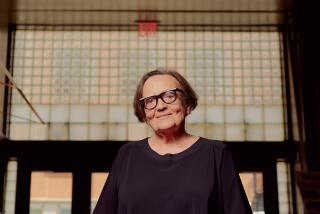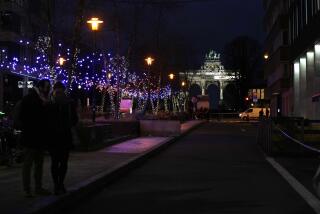EUROPE: FIVE YEARS LATER : Life Where the Curtain Parted : At border of Austria and Hungary where East-West barrier was first breached, dreams are panning out.
- Share via
HEGYESHALOM, Hungary — For much of Europe, the collapse of the Iron Curtain has been a mixed blessing--a paradoxical blend of soaring hope and crushing disappointment.
Not so here.
Along the Austrian-Hungarian frontier that once separated the Communist, totalitarian East from the democratic, free-market West, there is little argument: Life is decidedly better.
Here, in this small Hungarian town and the Austrian farming village of Nickelsdorf three miles west across a mix of corn and potato fields, dreams are panning out.
The two communities, which for 40 years existed as isolated outposts in their respective political worlds, today find themselves at the center of a new Europe--much as their respective mayors had predicted in interviews during the summer of 1989.
Whiffs of change were in the air back then, but no one went so far as to talk of revolution, and no one thought of communism’s imminent demise. Not even when the media converged on the area briefly to watch Hungarian soldiers tear out the first small section of the Iron Curtain did predictions go that far.
After all, Solidarity’s stunning election victory in Poland was still a month away, the collapse of the Berlin Wall merely a vague hope.
The fact that, within 2 1/2 years, Soviet President Mikhail S. Gorbachev and then the Soviet Union itself would disappear, was simply inconceivable in those first days of the summer of 1989.
Today, life along the old East-West divide thrives in a very different world--a world where a dangerous but stable superpower rivalry has gone, where only the United States exercises a genuine global role and where a new Russia struggles to define its place and its interests.
“We haven’t developed as much in our entire history as we have in the past five years,” noted Hegyeshalom’s mayor, Zoltan Vincze.
He reeled off a list of accomplishments that began with a new indoor sports hall and leisure center and ran through the extension to the water system, new gas connections, a cable TV system, improved street lighting, a doubling of the number of telephones, renovation of the dentist’s office and the arrival of a second doctor in this town of about 4,000.
“For the first time, we have a pediatrician here,” he said, pausing briefly for effect. “Things have really turned out well.”
Nearly half the town’s state-owned land has been privatized, 10 new grocery stores have opened, unemployment is steady at 4% to 5%, several homes have been repainted, the church has a new roof and when Vincze makes his rounds, he no longer drives a Russian-made Lada but a Peugeot 305.
Across the frontier in Nickelsdorf, it’s also been a good five years.
In the summer of ‘89, as Europe edged toward the brink, Mayor Gerhard Jocham saw the political liberalization in Hungary and Poland as a chance to breathe new life into his isolated village.
With luck, he said then, the exodus of young people that had drained the community of nearly half its population during the Cold War years might even be stemmed.
Today, Nickelsdorf’s population has not only stabilized, it’s beginning to grow.
Just off the village square in a tiny office crammed with official keepsakes and souvenirs, Jocham lists the prospects: 18 jobs at two filling stations about to open up on the new four-lane highway connecting Vienna and Budapest, a number of other jobs at a rest-stop hotel and still more at a 27-acre commercial park that will be built nearby.
“We’re hoping to have 2,000 people living here by the turn of the century,” he said. Such a figure would be a 20% jump over 1989.
With Austria set to join the European Union in January and Hungary having already formally applied, the border region’s future seems brighter still.
“If Hungary comes in, we’ll be in the middle of the world’s richest market,” he said. “Then, who knows?”
Much progress is already visible.
Last week, the final Austrian section of the Vienna-Budapest highway was opened to traffic, and work on the Hungarian side is scheduled for completion in June.
The streets of Nickelsdorf are also under construction, ripped open for the upgraded sewage system needed to accommodate the new hotel and commercial park.
Local officials expect work to start soon on new low-cost housing and upgraded shopping facilities, including a supermarket, drugstore and furniture outlet.
“At first, people are going to commute, but we want to give them a chance to live here too,” Jocham said.
To be sure, life hasn’t been all smooth sailing along this old Cold War frontier.
Hungarian skilled laborers willing to work illegally for a quarter the salary of their Austrian counterparts have eased unemployment in Hungary and lowered construction costs in eastern Austria, but they have also angered local workers and their union executives.
There have also been disappointments.
A shopping arcade on the Hungarian side just off the Vienna-Budapest highway that was once seen as a key money-earner for Hegyeshalom has been plagued with problems. Its original developers went broke last year, and with capital extremely short in Hungary, the venture was sold to a group of Libyans.
The new owners talk of expanding the arcade, adding stores and paving the dirt parking lot, but local officials still aren’t happy. They have a hunch the Libyans are using the arcade only as a money-laundering operation for more dubious business activities elsewhere.
Local officials also worry about the social costs of restructuring the town’s economy away from the stone quarry and railway that sustained it through the Communist era.
“It’s been like someone threw a light on after living 40 years in the dark,” Vincze said. “It’s been blinding. We’ve suddenly moved into a new age of technology, and the semi-skilled workers over 40 simply can’t deal with it. We thought we’d get more help, but we didn’t. We’ve learned that you have to help yourself.”
Vincze, whose years as mayor span Hungary’s transition to a multi-party democracy, also laments a gap of individual initiative between Hungarians and Austrians. “You’ve heard about the differences between East and West Germans?” he asked. “Well, here it’s worse. It’s the generations grown under communism. You’ve got to push, push and push some more.”
Whatever the coming years bring for the two communities, it will be tough to top the last five.
For both communities, the changes really began during the spring of 1989, when tens of thousands of Hungarians armed with special visas and enough hard currency to do some serious buying crossed into Austria and bought just about every television set, video recorder and microwave oven east of Vienna.
A few weeks later, the reformist Hungarian Communist government decided the Iron Curtain was out of date. It ordered troops in to roll up the barbed wire, dismantle the watchtowers and end the armed patrols.
It would be summer before the first East Germans vacationing in Hungary realized that they could reach the West by simply walking through these open fields, but once they did, the Berlin Wall would quickly fall.
In that hectic summer, Nickelsdorf became a boom town of sorts. With a population of 1,650, it sported no fewer than 28 stores catering to Hungarian day-trippers, selling consumer durables from TV sets to washing machines.
“Two for us, 26 for the Hungarians,” Jocham joked at the time.
Today, with the Hungarian demand satiated and money tight, three such shops remain. “We get some Hungarians in here, but the big rush is gone,” said an assistant at one of the stores on Lower Main Street.
At the Weiss grocery store a few doors down, customers still recall the out-of-towners who came in that summer to open large electronics stores along the main drag. “One of ‘em spent 5 million schillings ($500,000) for a place down there on the corner, but he was too late,” an elderly customer named Schmidt recalled. “He missed the wave and went broke within a year.”
Few in Nickelsdorf seem to lament the passing of the boom. Even fewer miss the traffic that tied the village in knots.
Today, it is as if the Iron Curtain had never been. There is no monument, no reminder, no real trace of Europe’s great scar. Just two mundane border stakes and a roughly cut strip of brown grass mark the line of the infamous barrier that divided the world into opposing armed camps for more than four decades.
It is a twist of history as well as a sign of new times that a watchtower recently sprung up on the Austrian side to help Austrian army patrols spot immigrants trying to slip into the country illegally.
But little stirs here, and amid the quiet of a mid-autumn afternoon, only one sound rises from the distance: the sound of heavy trucks moving east and west along the nearby highway.
Eastern European Economies
One way to measure economic reform in Eastern Europe is by the percentage of gross national product (GNP) contributed by private enterprise. Figures shown are estimates.
Private Sector Share of GNP (mid-1994)
Albania: 60%
Bulgaria: 40
Croatia: 40
Czech Republic: 65
Macedonia: 35
Hungary: 55
Poland: 55
Romania: 35
Slovakia: 55
Slovenia: 30
Source: European Bank for Reconstruction & Development
More to Read
Sign up for Essential California
The most important California stories and recommendations in your inbox every morning.
You may occasionally receive promotional content from the Los Angeles Times.













